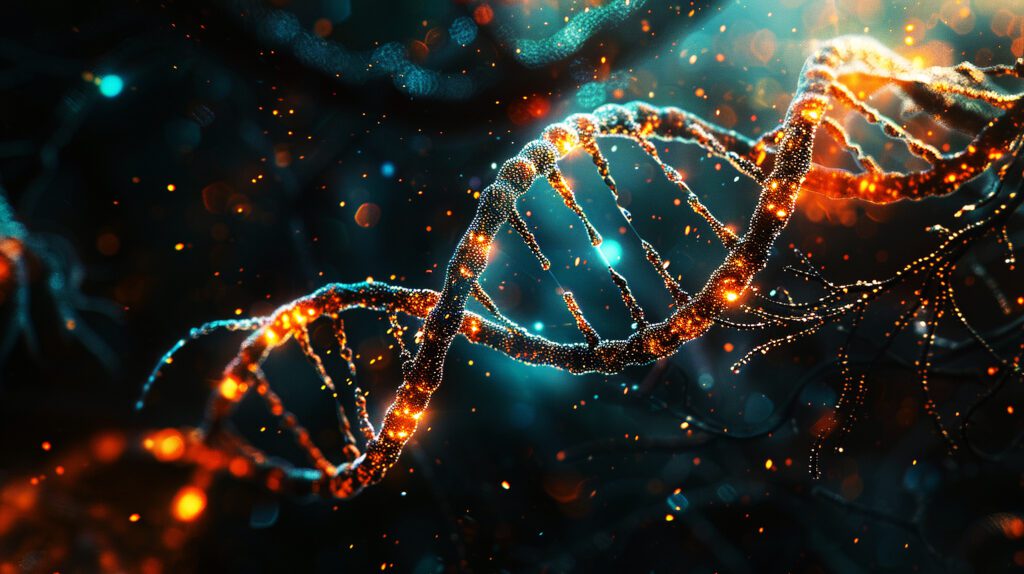צרו איתנו קשר!
צוהר לעולם הגנטיקה
A window to the world of genetics
About The Course
על הקורס
גנטיקה הוא תחום מרתק במדעי החיים, אשר מתמקד בחקר הבסיס המולקולארי של התורשה ובאופן שבו מידע גנטי מועבר מדור לדור. זהו שדה מחקר עשיר ומגוון, המשלב היבטים מתחומים שונים כגון ביולוגיה מולקולרית, ביוכימיה, אבולוציה ורפואה. במהלך הקורס, נעמיק בהבנת המבנה והתפקוד של הגנים, נחקור את דגמי ההורשה המגוונים ונבחן כיצד תכונות פיזיות ומחלות תורשתיות בקרב קרובי משפחה.
נלמד על חלוצי המחקר בתחום הגנטיקה, כמו גרגור מנדל, שסללו את הדרך להבנה מעמיקה של התהליכים המולקולאריים המונחים בבסיס העברת המידע הגנטי. סקרנותו של מנדל והניסויים החלוציים שערך על צמחי אפונה הובילו לגילוי חוקי ההורשה הבסיסיים, אשר מהווים את אבני היסוד להבנת הגנטיקה המודרנית. במהלך הקורס, נכיר את עבודותיהם הפורצות דרך של החוקרים הראשונים ונעריך את תרומתם המכרעת לתחום זה.
נבין את מושגי היסוד בגנטיקה, כמו הגן, הכרומוזום, גנוטיפ, פנוטיפ, אלל ומוטציה, יהוו את נקודת המוצא ללמודנו. נלמד להבחין בין הרכב גנטי (גנוטיפ) לביטוי התכונה הגלויה (פנוטיפ), ונבין כיצד גורמים שונים עשויים להשפיע על הקשר ביניהם. בנוסף, נרכוש מיומנויות בניתוח עצי משפחה גנטיים ובהכרת דגמי ההורשה הקלאסיים של מנדל.
לאחר הבנת הבסיס התאורטי, נמשיך לחקור דגמי הורשה מורכבים יותר, כולל הורשה דומיננטית לעומת רצסיבית, הורשה עם חדירות מלאה או חלקית, והורשה אוטוזומלית או מקושרת למין מסוים. נדגיש את החשיבות של הבנה מעמיקה של דגמים אלה עבור אבחון וייעוץ גנטי במצבים רפואיים שונים.
בחלק האחרון של הקורס, נתמקד בתהליכי החלוקה התאית והעתקת המידע הגנטי. נלמד על המנגנונים המבטיחים חלוקה שווה של החומר הגנטי לתאי הבת, ונבחן את ההשלכות של סטיות מתהליך זה, כגון אנאפלואידיות (טריזומיה ומונוזומיה). נסקור תסמונות גנטיות מוכרות הקשורות לשגיאות בחלוקת התאים, ביניהן תסמונת דאון, טרנר וקליינפלטר.
* הקורס יותאם לרמת כל שכבת גיל.
Genetics is a fascinating field within the life sciences that focuses on the molecular basis of heredity and the way genetic information is transmitted from generation to generation. It is a rich and diverse area of research, integrating aspects from various disciplines such as molecular biology, biochemistry, evolution, and medicine.
Throughout this course, we will delve into understanding the structure and function of genes, explore diverse inheritance patterns, and examine how physical traits and hereditary diseases manifest among family members. We will study the pioneers of genetic research, such as Gregor Mendel, who paved the way for a deep understanding of the molecular processes underlying genetic information transfer. Mendel's curiosity and groundbreaking experiments on pea plants led to the discovery of fundamental laws of inheritance, which form the cornerstone of modern genetics. During the course, we will familiarize ourselves with the breakthrough work of early researchers and appreciate their crucial contributions to this field.
Understanding the basic concepts in genetics, such as genes, chromosomes, genotype, phenotype, alleles, and mutations, will serve as the starting point for our studies. We will learn to distinguish between genetic composition (genotype) and the expression of visible traits (phenotype), and understand how various factors can influence the relationship between them. Additionally, we will acquire skills in analyzing genetic family trees and recognizing Mendel's classic inheritance patterns.
After grasping the theoretical foundation, we will proceed to explore more complex inheritance patterns, including dominant versus recessive inheritance, inheritance with complete or partial penetrance, and autosomal or sex-linked inheritance. We will emphasize the importance of a thorough understanding of these patterns for genetic diagnosis and counseling in various medical conditions.
In the final part of the course, we will focus on cell division processes and genetic information replication. We will study the mechanisms ensuring equal distribution of genetic material to daughter cells and examine the implications of deviations from this process, such as aneuploidy (trisomy and monosomy). We will review well-known genetic syndromes related to errors in cell division, including Down syndrome, Turner syndrome, and Klinefelter syndrome.
* The course material will be tailored to the age of the learners.







